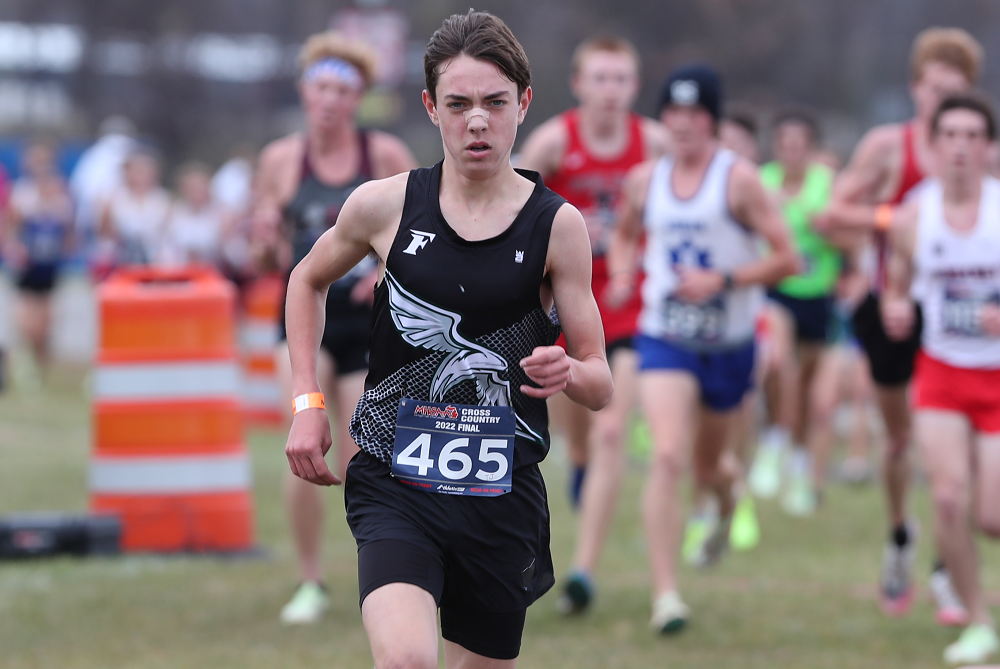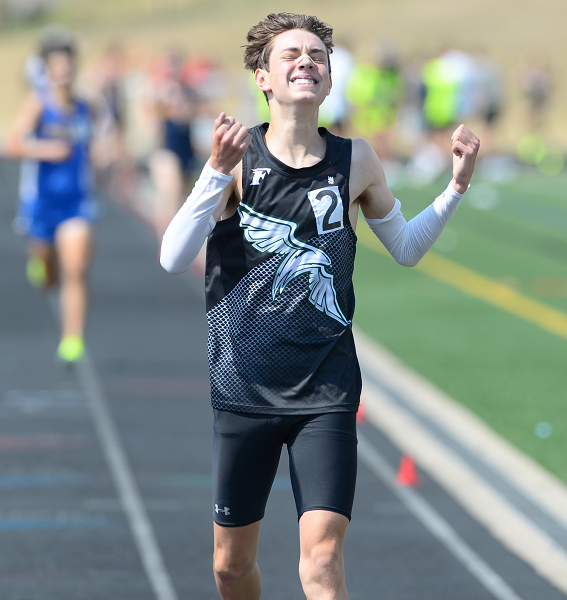
Gladstone Ace Shaving Seconds, Stacking Wins in Building Memorable Run
By
John Vrancic
Special for MHSAA.com
October 7, 2021
GLADSTONE — Drew Hughes has been piling up victories throughout this cross country season.
 The Gladstone High School junior won for the ninth time in as many races Tuesday, finishing first at the Gladstone Invitational at Richer's farmhouse.
The Gladstone High School junior won for the ninth time in as many races Tuesday, finishing first at the Gladstone Invitational at Richer's farmhouse.
That victory came three days after earning top honors at the Sault Ste. Marie Elks Invitational by covering the 3.1-mile course in 16 minutes, 35 seconds. At Munising on Sept. 28, he ran a personal-best 16:22.4 in the El Harger Memorial Invitational at Pictured Rocks Golf & Country Club, shaving seven seconds off his previous best at the Holly Invitational on Sept. 18 at Davisburg.
What has made him so successful?
“It’s probably the training I did this summer,” said Hughes, who averages 20 miles a week. “I ran with a lot of my friends, and they pushed me a lot. Although, most days I was running by myself. After a meet when I get a good time, I just want to keep getting better.”
Hughes has finished under 17 minutes in his last five races, including the John Prokos Memorial Invitational in Escanaba where he was clocked at 16:47 on Sept. 25. He also ran a 16:47 on Tuesday.
After the Holly Invite, he was selected the Athlete of the Meet for Division 3-4-5 after becoming the first male runner from the Upper Peninsula to take top individual honors in the meet’s 53-year history.
“I thought that was real cool,” said Hughes, who ran a 5:10 split in his first mile. “After the first mile, I wanted to keep that pace. I also wanted to make sure I didn’t burn out. I slowed down slightly in the second mile, but not too much. Coach (Gary Whitmer) told me my two-mile split. At that point, I wanted to go for under 17.”
Gladstone placed third at Sault Ste. Marie with 84 points. South Lyon won at 27, followed by the host Blue Devils with 51.
“My teammates and coaches have been very helpful, and they’ve been helpful and respectful to other teams,” said Hughes. “We’re a real good small team.”
On race day, he enjoys the competition and camaraderie with other runners.
“Marquette is real solid and fun to race against,” he said. “Houghton is doing well, and Sault is fun to race against. They have a nice course up there.
“My girlfriend and whole family come to the meets when they can. They’re also very supportive even when they can’t make it to the meets.”
Hughes started running in third grade under former coach Dan Paul.
“I just loved running,” he said. “My brother Luke was among the best runners in middle school, and that really motivated me. He had a lot of speed and height. In second grade, I started getting interested in running by watching him. They had a lot of people there. That was awesome.
“Our coach would treat us to ice cream after some practices. He and my grandfather came with us and rode their bikes while we were running.”
Hughes hopes to retain his Great Northern Conference title at Menominee on Oct. 14 and Mid-Peninsula Conference crown in Ishpeming on Oct. 18.
The season ends with the Upper Peninsula Finals on Oct. 23 at Gentz Golf Course in Chocolay Township (near Marquette). Hughes finished 12th in the Division 1 race in 2020.
 John Vrancic has covered high school sports in the Upper Peninsula since joining the Escanaba Daily Press staff in 1985. He is known most prominently across the peninsula for his extensive coverage of cross country and track & field that frequently appears in newspapers from the Wisconsin border to Lake Huron. He received the James Trethewey Award for Distinguished Service in 2015 from the Upper Peninsula Sportswriters and Sportscasters Association.
John Vrancic has covered high school sports in the Upper Peninsula since joining the Escanaba Daily Press staff in 1985. He is known most prominently across the peninsula for his extensive coverage of cross country and track & field that frequently appears in newspapers from the Wisconsin border to Lake Huron. He received the James Trethewey Award for Distinguished Service in 2015 from the Upper Peninsula Sportswriters and Sportscasters Association.
PHOTO Gladstone's Drew Hughes leads and wins the Dale Phillips Invitational on Sept. 3 at Presque Isle Park. (Photo by Cara Kamps.)

Freeland's Hansen Not Focused on Joining All-Time Greats - But On His Way
By
Paul Costanzo
Special for MHSAA.com
September 29, 2023
The goal written on Matt Kaczor’s Post-It Note was sub-15 minutes, 15 seconds. That’s what the Freeland cross country coach was hoping for from star runner TJ Hansen during his junior season.
 Kaczor tore it up after seeing Hansen run a single race this fall.
Kaczor tore it up after seeing Hansen run a single race this fall.
“Knowing what he did over the summer and where he was at, seeing what his 1,600 (meter) and his mile got down to, I had a feeling he could get under 15:30 quickly,” Kaczor said. “After the first race, I looked at my assistant and was like, ‘I’ve gotta rip up that Post-It Note. I don’t think our goal is on the level of where he’s at right now.’ At first, it was break 15:15. Once I saw him race at the Under the Lights (on Aug. 18 at St. Johns), I was like, ‘Yeah, he’s going sub 15.’”
Hansen ran 15:39.6 in that first race, and on Sept. 7, in Shepherd, he ran 15:13.9 to meet the goal written on the now-shredded Post-It Note.
This past Saturday, he ran 15:03.7 at the Cadillac Veterans Serving Veterans Invitational. It’s the fastest time recorded in Michigan this year, and a signal that Kaczor might be filling out a new Post-It Note before the season is out.
“The sub-15 barrier, that’s been something on my mind for a while,” Hansen said. “Now that I’m edging closer and closer to that, it’s been exciting. With how heavy my training has been, I wouldn’t expect (to have run this fast this early). Being able to run the times I am really paints the picture for what’s ahead.”
Hansen came into the season already regarded as one of the elite distance runners in the state. He won the 3,200 meters at the MHSAA Lower Peninsula Division 2 Track & Field Finals this past spring. He’s also finished all-state (12th and fifth, respectively) the past two seasons at the LPD2 Cross Country Finals.
His current trajectory, however, would put his name near some of the state’s all-time greats. But that’s not something Hansen is focusing on.
“I really don’t like to compare myself to others,” he said. “I don’t focus on that. I try to be the best TJ Hansen that I can be. The best version of myself.”
Focusing on himself is almost necessary for Hansen, as he’s spending a lot of time during his races running by himself.
At each of the big events Freeland has run in this season, Hansen has finished at least 20 seconds ahead of his nearest competitor. That includes all divisions of the Duane Raffin Festival of Races in Holly.
In Cadillac, where Hansen ran his current best time, he was a full minute ahead of the rest of the field.
 “He’s just a special athlete,” Kaczor said. “I can’t see Freeland having someone like this in a while. He’s a generational talent. What’s crazy is, I had the school record when he was a freshman. He and Braden (Honsinger) broke it last year. But TJ has now dropped that school record (set in 1998) by almost a minute.”
“He’s just a special athlete,” Kaczor said. “I can’t see Freeland having someone like this in a while. He’s a generational talent. What’s crazy is, I had the school record when he was a freshman. He and Braden (Honsinger) broke it last year. But TJ has now dropped that school record (set in 1998) by almost a minute.”
Hansen’s achievements have already put him on a path to run at the next level, which is something of a family tradition.
His older sisters Peyton and Kiera are track & field athletes at Wayne State and Eastern Michigan, respectively. Their parents, Tim and Pam, were track & field stars at Central Michigan.
TJ has drawn the attention of coaches around the country, including from Michigan, Michigan State, Wisconsin, Tennessee and Colorado.
Having family members who know the process is a help for Hansen, and he said they’ve all been good about allowing him to choose his own path, whatever that may be.
“He’s from a good family that knows how to work and knows how to get things done,” Kaczor said. “He knows that if he puts in the work, he’s going to be at a good spot.”
While Hansen admits it can be a bit overwhelming, he’s using it as motivation to run faster and continue to put his name out there.
Also serving as motivation is 2022 Division 2 champion Connell Alford of Chelsea. Alford is among the elite group of runners in Michigan who have broken the 15-minute mark, doing it twice a year ago.
He currently has the state’s second-best time behind Hansen’s this year, running 15:09.1 at the MSU Invitational on Sept. 15.
“Whenever I see him drop a time, my main goal is to run faster,” Hansen said. “Whenever I see him run a good time, that motivates me to work hard.”
The two won’t see each other until the MHSAA Finals on Nov. 4 at Michigan International Speedway. It’s an opportunity Hansen is excited for, as it’s a chance to race and be pushed toward the lofty goals he’s set for himself. Kaczor is excited about it, too, even if it might mean having to replenish his supply of Post-Its.
“We don’t talk about winning the state title; we talk about making sure that we have great races on those days,” Kaczor said. “We can’t control how somebody else runs. It’s a matter of can we, if the weather is right and the course is in good condition, can we be one of the few guys that has run in the 14s on that course? That’s the goal. Put yourself in some great categories with those upper echelons and the greats of all-time.”
 Paul Costanzo served as a sportswriter at The Port Huron Times Herald from 2006-15, including three years as lead sportswriter, and prior to that as sports editor at the Hillsdale Daily News from 2005-06. He can be reached at [email protected] with story ideas for Genesee, Lapeer, St. Clair, Sanilac, Huron, Tuscola, Saginaw, Bay, Arenac, Midland and Gladwin counties.
Paul Costanzo served as a sportswriter at The Port Huron Times Herald from 2006-15, including three years as lead sportswriter, and prior to that as sports editor at the Hillsdale Daily News from 2005-06. He can be reached at [email protected] with story ideas for Genesee, Lapeer, St. Clair, Sanilac, Huron, Tuscola, Saginaw, Bay, Arenac, Midland and Gladwin counties.
PHOTOS (Top) Freeland's TJ Hansen leads a pack during last season's LPD2 Final at Michigan International Speedway. (Middle) Hansen enjoys a moment of exhilaration after winning the 3,200 this spring at the LPD2 Finals at Ada Forest Hills Eastern. (Top photo by Carter Sherline/Run Michigan; middle photo by Dave McCauley/Run Michigan.)

